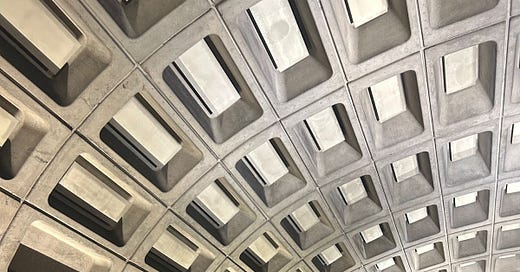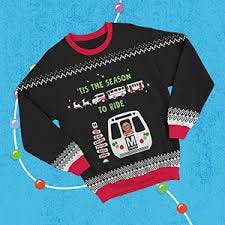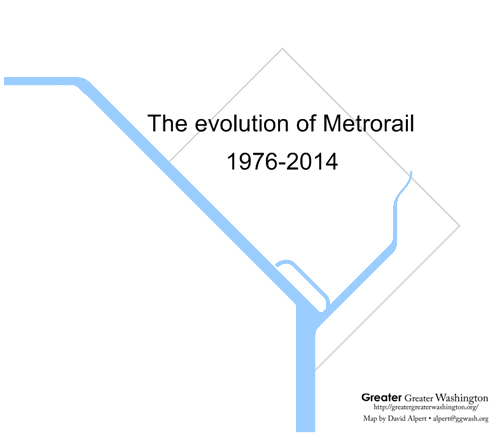This is the ninth post in a pop-up newsletter about the parts of DC you’ve probably never thought about. We’ve previous talked about wildlife, DC’s origin story, and its geology; here’s the intro to the project.*
Also, I’ll be hosting a farewell walking tour on June 28th trying to put a lot of what we’ve discussed (and things we haven’t yet) in the context of a specific neighborhood in DC — my neighborhood, Dupont. It’s partly my way of saying goodbye to the city, since I’ll be leaving at the end of the month.
The idea is for us to walk around Dupont and talk about all the things that we depend on but we often don't notice — whether we're so used to them or because they're literally buried deep underground or things we may not even realize are infrastructure.
We'll start at Dupont Circle at 2pm — I'll be holding a blue umbrella.
RSVP here. Hope to see you there!
During the pandemic, I stopped taking the metro, and even when things had returned to ‘normal’, prided myself on walking everywhere I could. It was a depressing reminder of my intern days — a kind of prison I was forced to sit in twice a day while refusing to accept that this is what adulting was all about.
But when my year of DC microadventures started, I realized I had forgotten how to use the metro. My first few times back on it, I missed my stop 3 straight times, and once looked so confused while trying to transfer lines that someone came up to me to ask if I needed help.
After I had relearned how to navigate the system, getting on felt like embarking on a little adventure. Checking off new stations became a game, with extra points for an end-of-the-line station like Greenbelt or Largo, whose names I had seen so many times but never thought I would visit. At the end of each month, I could see the dent I was making for the first time in my monthly SmarTrip allowance.
It’s one of those things that makes me feel the most connected to DC — it’s one of the most visible symbols of the city.
And so perhaps it’s fitting that it elicits such contradicting reactions. On one hand, every new week seems to bring a new article hand-wringing over Metro’s finances. As Zachary Schrag, preeminent historian of the Metro, put it, other than a few weeks in 1972, the metro has perpetually been in fiscal crisis. (I don’t know what happened in 1972.) WAMU1 even had a podcast titled “Metropocalypse” about consistent operational failures — including high-profile incidents like fires and crashes.2
And yet, people love it. The head of Metro, Randy Clarke, gets mobbed for selfies at sold out Metro events.3 (People say he looks like a Canadian George Clooney, which may help.) A talk I went to about the history of the metro sold out not only the first time but again a few months later. And of course there’s the merch: I have multiple friends who were first in line to buy a Christmas Metro sweater.
Metro has been the subject of heated public debate well before it was even born. Will it ever grow past that?
Urban subway systems in general are a public good because it’s a terrible business: no private operator would want to touch it (and none have, making every U.S. urban metro system publicly owned and operated). In DC, for example, fare fees only cover 17% of the cost to run the system.
So you need to capture some of the excess value that metros create (e.g. by raising surrounding property values) through taxes. This is why “most big cities dedicate a tax — often a sales tax — to finance public transit”.
But DC doesn’t have that. Instead, each of Metro’s 7 jurisdictions4 raised debt to finance the initial construction of the metro. But they didn’t think too much about paying for the ongoing operational costs. People refer to this as Metro’s original sin, because it has meant that every county has to be cajoled into coughing up hundreds of millions of dollars every year to cobble together enough funds to keep Metro going another year.
(By the way, this split governance, as you can imagine, complicates things. For example, DC wanted to give $100 in metro credit to its citizens out of its own budget, but since the others didn’t want to pay for it, it got shutdown for DC too.)
If you take a step back, it’s kind of extraordinary that we have a massive public transit system in DC at all — the U.S. is not exactly known for those. It didn’t come without a fight.
The mid-1900s were characterized by white flight from cities to the suburbs; downtowns became associated with poorer, minority populations. A transport official’s job was simple: get the white, white collar workers from the suburbs to their offices downtown. The federal government was doling out money to states for highways, so all across North America, plans to build new highways popped up. Many succeeded (like Providence), while some were stopped thanks to public pressure (famously thanks to led by Jane Jacobs in New York), and some fell apart partly thanks to divine intervention (an earthquake hitting in San Francisco severely damaged the highway).
In DC, the proposed highways would have cut the city into pieces; they even planned to build an expressway along the National Mall. As Schrag put it: imagine the National Mall without any people, and instead as the widest median strip in the country.
Urban residents knew that highways meant pollution, noise and even displacement.
Metro came out of the community activism against these plans, but it retained its original goal: bringing suburban commuters into the city. You can see how far Metro stretches out geographically from DC in this map re-sized to scale
A goal that took priority over facilitating movement within the city and making it a better place to live. It’s also reflected in the order in which lines were built: the Green line, serving the densest part of the city, was only created after activism from Black residents and only completed in 2001, 25 years after the Red line was opened to the public.
Building the Metro through the middle of a city wasn’t straightforward either. As Schrag put it, it seemed like every tree and statue had to be fought over.5 We can see the legacy of those battles today: We have two Farragut stations because the original plan — making one station under Farragut Square — was vetoed by the National Park Service, who were worried about hurting the trees and didn’t want to move the Admiral Farragut statue. The reason the Green line takes a detour is because planners wanted to use it to revitalize the area affected by the riots following MLK’s assassination in 1968. (Perversely, the increase in property values led to those original residents being displaced).
Understanding what it took to create Metro reminds me that it was by no means given. It also helps me remember the cost: the construction of Metro sometimes disrupted the lives of residents for years, even when they initially were told it would only be for a few weeks. (After construction was finally over, Ben's Chili Bowl displayed a banner proclaiming "We Survived Metro.")
Despite all the annual fiscal drama and the operational hiccups, people still love the metro. I have a few hypotheses.
One is the scale and the engineering marvel of it all: big infrastructure projects, whether it’s bridges or metros, are one of the few remaining sources of awe in the modern world. And maybe a system that runs, for the most part, smoothly, is worthy of awe — across 166 million trips annually, dozens of miles of underground tracks, and tunnels literally going under a river.
One of the unique experiences of the DC Metro is budgeting a few minutes to ride down impossibly long escalators, often so long they’re broken into multiple escalators. In fact, the DC Metro holds the honor of having the longest escalator in the Northern Hemisphere, at Wheaton station. At 230 ft long, you need to budget two and a half minutes to descend.
Why are the escalators so long, or rather, why is the metro so deep underground? After all, it often just takes a few sets of stairs in New York to reach the platform. It comes back partly to geology: you have to dig for a while to get to bedrock, which can absorb the load of a 30+ tons train.6 Manhattan, by contrast, has plenty of bedrock right below the surface.
And don’t forget that going between Foggy Bottom and Rosslyn means that you’re literally! Under! The! Water!
Other hypotheses on why people love Metro:
There’s no denying it — the DC metro is beautiful.7 The high ceilings and the gentle lighting make the stations feel more like a cathedral than an underground tunnel. The unfinished concrete walls with slats carved out shouldn’t work but they do. It’s a wonderfully quiet metro, especially when you compare it to NYC’s screeching. (This is thanks to longer tracks of welded rail, but it’s hard to be too mean to New York here because ours came 75 years later.)
The system runs not only on money or electricity — as GM Clarke put it, it runs on vibes. The feeling of pride and convenience is what keeps people coming back and what ensures public support and advocacy on behalf of the metro.
And the Metro’s social media strategy is working — even on me, someone who can only offer up my LinkedIn as a way to connect on socials. I first learned about the social media strategy through the video advertising Metro’s matchmaking credentials with six-foot men in finance. But there have been plenty of others, like the Metro employees doing the Hot to Go dance on the subway escalator at National Airport. And then of course there is the visual and linguistic personality that comes through things like the eminently shareable Metro Rewind and the quirky Netflix-like announcements about amusing usage patterns (like the one calling out the person only took the metro to Caps games).
They all serve to turn Metro from something you’re forced to take to something you can boast about.
Metro is many things at once: a monster of an infrastructure project, the idea that unites a city, and a fiscal sink that may never be sustainable.
Will it survive the test of time? I’m not sure. Even Schrag, who has devoted much of his career to studying the system, is ambivalent about it. In some ways, it is the product of a past era, and the costs of keeping the system running in its current form are only going to increase. (Perversely, Metro was one of the few beneficiaries of the mandated return to office for federal workers.8)
All I know is that it’s here, and our job is to steward it as well as we can. Long live the Christmas sweaters!
Microadventure
Take the longest escalator in the North Hemisphere at Wheaton
Go all the way to the end of a line you haven’t been to
A local news radio station
From the mundane (delays) to the genuinely scary (drunk driving, fires, crashes). A 2009 crash at Fort Totten killed nine people and resulted in the federal government taking over Metro safety. It’s the reason automated operation of speed was suspended (even though that wasn’t the cause of the incidents) and why it takes so long after docking into the station for the metro doors to open. We’ve just brought automation back, 16 years later.
After one maintenance project was completed ahead of schedule, one commenter wrote, “Please run for president, Randy.”
I.e. cities and counties: District of Columbia, Montgomery County, Prince George's County, Arlington County, Fairfax County, Loudoun County, and the cities of Alexandria, Falls Church, and Fairfax.
The main thing I thought I knew about Metro history — how the elite Georgetown-ites didn’t want the plebs coming to their area with the metro — isn’t true. It was mostly not built for practical reasons: it wasn’t really a commuter destination, there were engineering challenges to route the metro above the incline and also to blast through particularly hard bedrock, and then the construction challenge of navigating the historic preservation sites.
There are a few additional reasons it’s so deep, including going under waterways (like the Rock Creek River and Potomac rivers) and avoiding messing with everything else that was underground (building foundations, utility lines, etc).
Check out photographer Ty Cole who had a whole series devoted to it at the National Building Museum.
It’s a reminder that the system was always predicated on people working a lot, and working in downtowns. It’s the same for city budgets: officials want people to commute to office because it means more tax revenue. The high-wire act that is a city depends on the machinery spinning, even if that machinery is big stadiums, or big housing developments, or… big spas.











